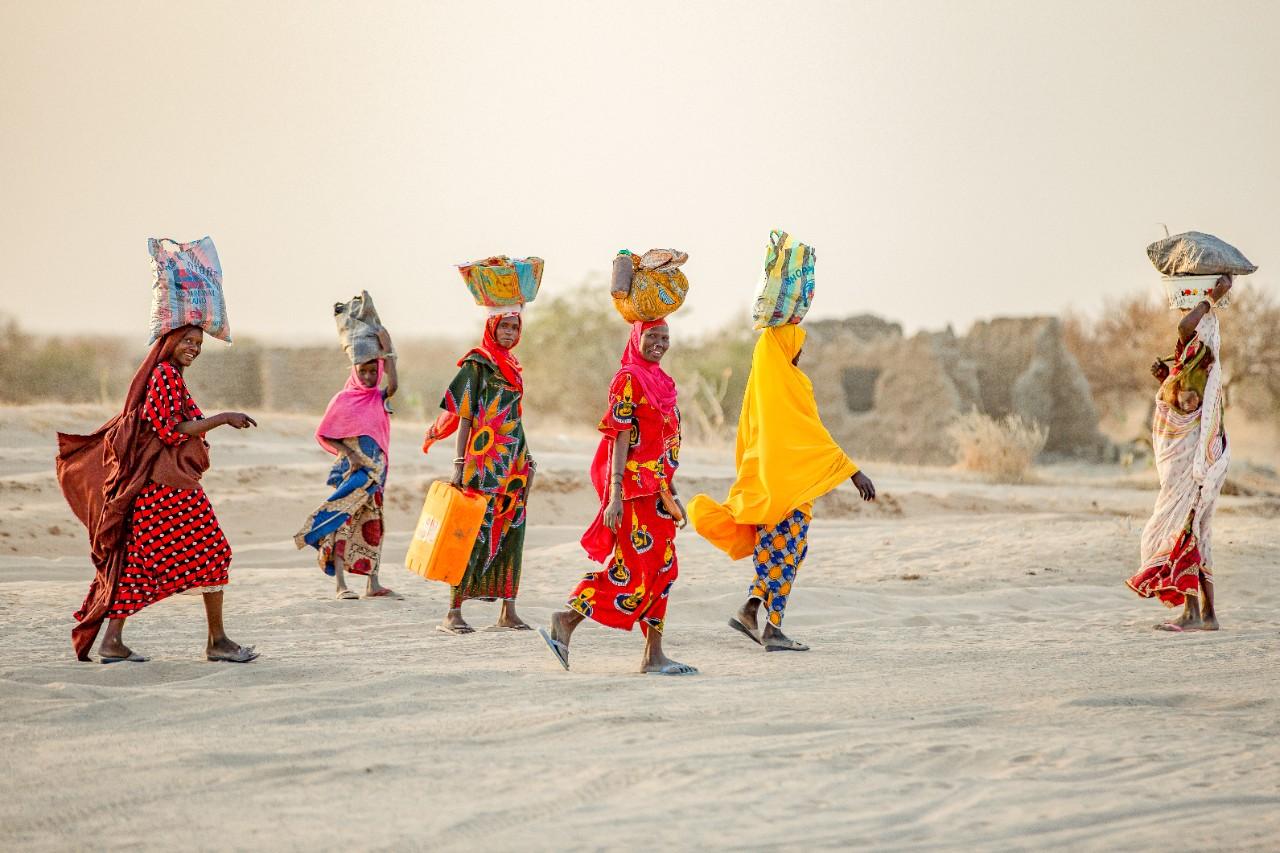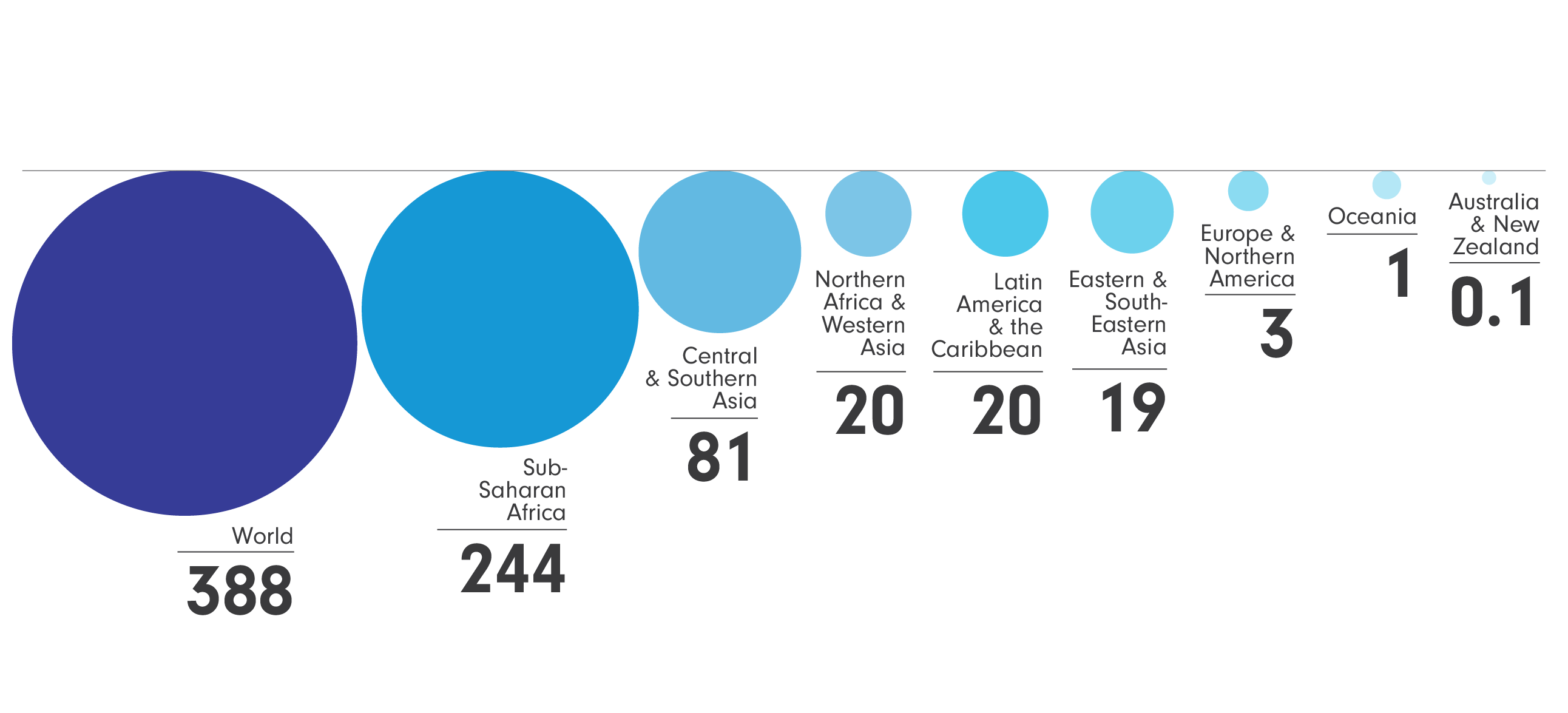
Two years on, the unpredictable course of this pandemic continues to upend prospects for growth and poverty reduction.
New projections of global poverty by UN Women, UNDP and the Pardee Center for International Futures estimate that, globally, 388 million women and girls will be living in extreme poverty in 2022 (compared to 372 million men and boys). But the outlook could be far worse. In a “high-damage” scenario, this number could balloon to 446 million (427 million for men and boys).
Global extreme poverty headcounts, base and high-damage forecasts, by sex (2017-2030)

Source: UN Women, UNDP and Pardee Center for International Futures using the International Futures modeling platform.
Note 1: Based on a sample of 186 countries. The base scenario reflects the impact of the pandemic on GDP growth based on IMFs October 2021 World Economic Outlook report. It also assumes that wage gap rises between women and men as a proxy for COVID’s disproportionate impact on female employment and increase in births in 2020-2022. The high damage scenario is based on the following assumptions: Distribution of calories worsens over time; Rather than stemming mostly from underutilized capital, the economic shock of COVID leaves a more lasting scar on economic productivity; Inequality increases by 5 percent globally; Countries take on greater debt; Severe Acute Malnutrition is worse in 2020 and contributes to higher stunting levels; High debt-risk countries see a 5 percent reduction in expenditures over the coming decade; Education enrolment and quality drop in countries with significant education disruptions; Low- and lower-middle income countries experience a higher degree of child undernourishment; Wage gap rises between women and men as a proxy for COVID’s disproportionate impact on female employment and increase in births in 2020-2022. Note 2: This analysis is based on household-level data. Individual-level data on extreme poverty are not available. For full methodological description see Technical Note.
According to these new forecasts, 83.7% of the world’s extreme poor women and girls would live in just two regions: Sub-Saharan Africa (62.8%) and Central and Southern Asia (20.9%).
Female population living in extreme poverty, by region, 2022 (in millions)

Source: UN Women, UNDP and Pardee Center for International Futures using the International Futures modeling platform.
Note: Based on a sample of 186 countries. 62.8% of extreme poor women live in Sub-Saharan Africa, 20.9% in Central and Southern Asia, 5.3% in Latin America and the Caribbean, 5.1% in Northern Africa and Western Asia, 4.8% in Eastern and South-Eastern Asia, 0.8% in Europe and Northern America, 0.3% in Oceania (excluding Australia and New Zealand) and 0.01% in Australia and New Zealand. The country groupings are based on the geographic regions defined under the Standard Country or Area Codes for Statistical Use (known as M49) of the United Nations Statistics Division.
For the first time, this data update also offers a glimpse into projections of poverty by sex at $3.20, $5.50 and national poverty lines, revealing interesting patterns. For example, in Latin America and the Caribbean, only 2.2% of women and girls live in poverty at the $1.90 poverty line, but this share rises to 30% when national poverty estimates (anchored to a specific threshold of median income of the country in the measurement/projection period) are used. In all regions of the world, female poverty rates are higher than male poverty rates in at least one poverty threshold ($1.90, $3.20, $5.50 and national poverty line).
Female poverty rates by region, using the US$1.90, US$3.20 and US$5.50 line, 2022 projections

Source: UN Women, UNDP and Pardee Center for International Futures using the International Futures modeling platform.
Note: Based on a sample of 186 countries..
Female poverty rates by region, using national poverty line estimates, 2022 projections
Source: UN Women, UNDP and Pardee Center for International Futures using the International Futures modeling platform.
Note: Based on a sample of 186 countries..
Despite the damage inflicted by the pandemic, this further deepening of poverty is not a foregone conclusion. With sufficient policy intervention and a push to achieve the Sustainable Development Goals (SDGs), these trends can be reversed for the better. In fact, a simulation analysis shows that an integrated policy approach— including more spending on social protection, investments in the green economy, better infrastructure and education—would lift close to 150 million women and girls out of poverty by 2030.
These estimates are a limited release from an ongoing collaboration between UN Women, UNDP and the University of Pardee Center for International Futures using the International Futures Modelling Platform. Forecasts and projections are subject to uncertainty due to the ongoing COVID-19 pandemic. Please check this page for regular updates on this project and additional data releases.
Access the data
Ginette Azcona is a Research and Data Policy Specialist at UN Women. She manages the data and statistics for UN Women’s flagship reports. Before joining UN Women in 2010, she was part of the research and writing team for UNDP’s Human Development Report Office. Ginette has authored numerous publications on human development, human rights, social justice and gender and development data and is UN Women’s leading focal point on gender, data and the SDGs.
Antra Bhatt is a Statistics Specialist with UN Women’s Research and Data Team. Prior to joining UN Women, she was a researcher at Tata Institute of Social Sciences, Mumbai, India. She holds a PhD in International Development from the University of Rome –‘Tor Vergata’, Italy and a Master’s degree in Public Policy from the University of Chicago Harris School of Public Policy.

